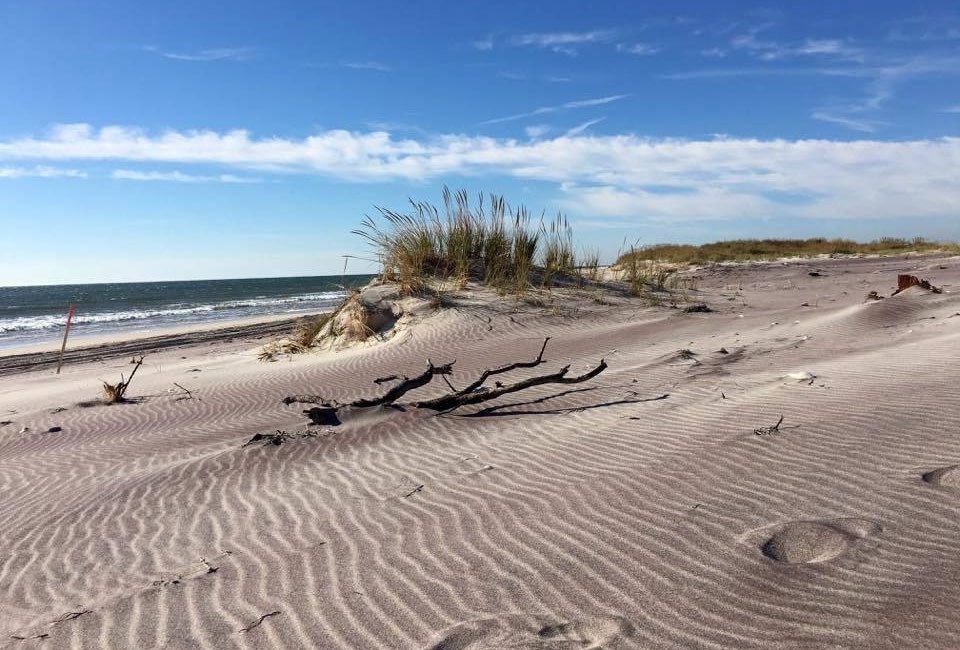Part of a series of articles titled Beach and Coastal Landforms.
Previous: Rocky Coast Landforms
Next: Estuary Landforms
Article

NPS Photo
Sandy beaches are highly dynamic environments subject to rapid, extreme changes. Typically located on passive margins, in areas characterized by low-wave energy, a wide continental shelf, and high offshore sediment influence, sandy beaches are found in wave-dominated, depositional settings such as the Atlantic Ocean and Gulf of Mexico coasts. Many of our favorite beaches are found on sandy coasts: Cape Cod National Seashore in Massachusetts, Cumberland Island National Seashore in Georgia, Assateague Island National Seashore in Maryland and Virginia, Padre Island National Seashore in Texas, and Gulf Islands National Seashore in Florida and Mississippi.
Sandy beaches may be found in other tectonic settings or depositional environments, such as pocket beaches at Channel Islands National Park and beaches near the mouth of San Francisco Bay at Golden Gate National Recreation Area in California.
Depositional settings along sandy coasts produce barrier structures such as bay barriers, barrier spits, and barrier islands. Coastal barriers are highly complex and dynamic landforms that experience constant change and movement. These narrow strips of sand serve as obstacles to wave activity, protecting fragile environments that lay further inland, for example, marshes, tidal flats, and lagoons.
Depositional processes along coastlines, such as sediment transport, form sandy beaches and create highly complex landforms that experience constant change and movement. Features such as spits, barrier islands, tombolos, and dunes are classic forms in sandy beach environments.
Barrier islands are one of the most common and distinguishable features of the Atlantic coast. These important environments protect the mainland from storm events and wave action, while providing a vital ecosystem for many species. Features such as sand dunes, maritime forests, inlets, lagoons, back-barrier marshes, and vegetation constitute these fragile coastal systems. Without intervention, barrier islands maintain a state of dynamic equilibrium between sediment exchange, wave energy, and sea level rise. Human activities may interfere with this balance, causing costly damage, both economically and environmentally.
Barrier spits are made up of sediments that have been suspended by waves and transported by currents. A barrier spit is the landform resulting from the deposition of sediments in long ridges extending out from coasts. Barrier spits may partially block the mouths of bays. If a spit grows long enough, it can completely cut off a bay from the ocean, forming a lagoon. The spit is then called a bay barrier or a bay-mouth bar. Cape Cod (Massachusetts) is a famous cape that terminates at Provincetown spit.
Although varying in length, width, sand composition, and permanence, beaches are the most well-known coastal feature. A beach is defined as the location along a shoreline where the sediment is in motion, being moved by waves, tides, and currents. The beach is often bounded on the upland side by a cliff, dune, or vegetation. Beaches are very dynamic environments, with coastlines that can change daily, making them challenging places to manage.
Dunes are critical to the health and sustainability of sandy beaches. The primary dune ridge (foredunes) lies adjacent to the shoreline. Secondary dune fields may lie further inland. Dunes may form anywhere that eolian processes (wind transportation) occur. Dunes provide much-needed protection to back-barrier environments (including human development) against severe wave, wind, and storm events. In addition, these geomorphic features provide critical habitat to a variety of migratory birds and mammals. Dune vegetation is very important for the formation and stabilization of dune complexes on barrier islands. Both the root system and exposed vegetation restrict sand movement around plants, helping to build and secure the dune.
A tombolo is created when sediment connects an offshore landform—such as an island or a sea stack—with the mainland. The tombolo forms because the island or sea stack refracts the waves, causing a zone of slow moving water behind the island. Whenever water carrying sediment slows down, sediment is deposited. The sediments that form tombolos often form in ridges along an underwater wave-cut terrace.
Part of a series of articles titled Beach and Coastal Landforms.
Previous: Rocky Coast Landforms
Next: Estuary Landforms
Last updated: December 11, 2019